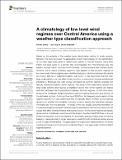Mostrar el registro sencillo del ítem
A climatology of low level wind regimes over Central America using a weather type classification approach
| dc.creator | Sáenz Soto, Fernán | |
| dc.creator | Durán Quesada, Ana María | |
| dc.date.accessioned | 2018-11-07T20:52:30Z | |
| dc.date.available | 2018-11-07T20:52:30Z | |
| dc.date.issued | 2015-04 | |
| dc.identifier.citation | https://www.frontiersin.org/articles/10.3389/feart.2015.00015/full | |
| dc.identifier.issn | 2296-6463 | |
| dc.identifier.uri | https://hdl.handle.net/10669/76081 | |
| dc.description.abstract | Based on the potential of the weather types classification method to study synoptic features, this study proposes the application of such methodology for the identification of the main large scale patterns related with weather in Central America. Using ERA Interim low-level winds in a domain that encompasses the intra-Americas sea, the eastern tropical Pacific, southern North America, Central America and northern South America, the K-means clustering algorithm was applied to find recurrent regimes of low-level winds. Eleven regimes were identified and good coherency between the results and known features of regional circulation was found. It was determined that the main large scale patterns can be either locally forced or a response to tropical-extratropical interactions. Moreover, the local forcing dominates the summer regimes whereas mid latitude interactions lead to winter regimes. The study of the relationship between the large scale patterns and regional precipitation shows that winter regimes are related with the Caribbean-Pacific precipitation seesaw. Summer regimes, on the other hand, enhance the Caribbean-Pacific precipitation with contrasting distribution as a function of the dominant regimes. A strong influence of ENSO on the frequency and duration of the regimes was found. It was determined that the specific effect of ENSO on the regimes depends on whether the circulation is locally forced or lead by the interaction between the tropics and the mid-latitudes. The study of the cold surges using the information of the identified regimes revealed that three regimes are linkable with the occurrence of cold surges that affect Central America and its precipitation. As the winter regimes are largely dependent of mid-latitude interaction with the tropics, the effect that ENSO has on the Jet Stream is reflected in the winter regimes. An automated analysis of large scale conditions based on reanalysis and/or model data seems useful for both dynamical studies and as a tool to support forecasting. The application of the approach implemented in this study may be promising to improve current understanding on how large scale conditions affect regional weather. | es_ES |
| dc.description.sponsorship | Universidad de Costa Rica/[805-B3-600]/UCR/Costa Rica | es_ES |
| dc.language.iso | en_US | es_ES |
| dc.relation.ispartof | ||
| dc.source | Frontiers in Earth Science, vol.3, pp. 1-18 | es_ES |
| dc.subject | Central America | es_ES |
| dc.subject | Precipitation | es_ES |
| dc.subject | Weather type | es_ES |
| dc.subject | Wind | es_ES |
| dc.subject | Cold surge | es_ES |
| dc.subject | 551.672 8 Climatología y estado atmosférico | es_ES |
| dc.title | A climatology of low level wind regimes over Central America using a weather type classification approach | es_ES |
| dc.type | artículo original | |
| dc.date.updated | 2018-10-09T20:55:43Z | |
| dc.identifier.doi | 10.3389/feart.2015.00015 | |
| dc.description.procedence | UCR::Vicerrectoría de Investigación::Unidades de Investigación::Ciencias Básicas::Centro de Investigaciones Geofísicas (CIGEFI) | es_ES |
| dc.identifier.codproyecto | 805-B3-600 |
Ficheros en el ítem
Este ítem aparece en la(s) siguiente(s) colección(ones)
-
Meteorología [509]


